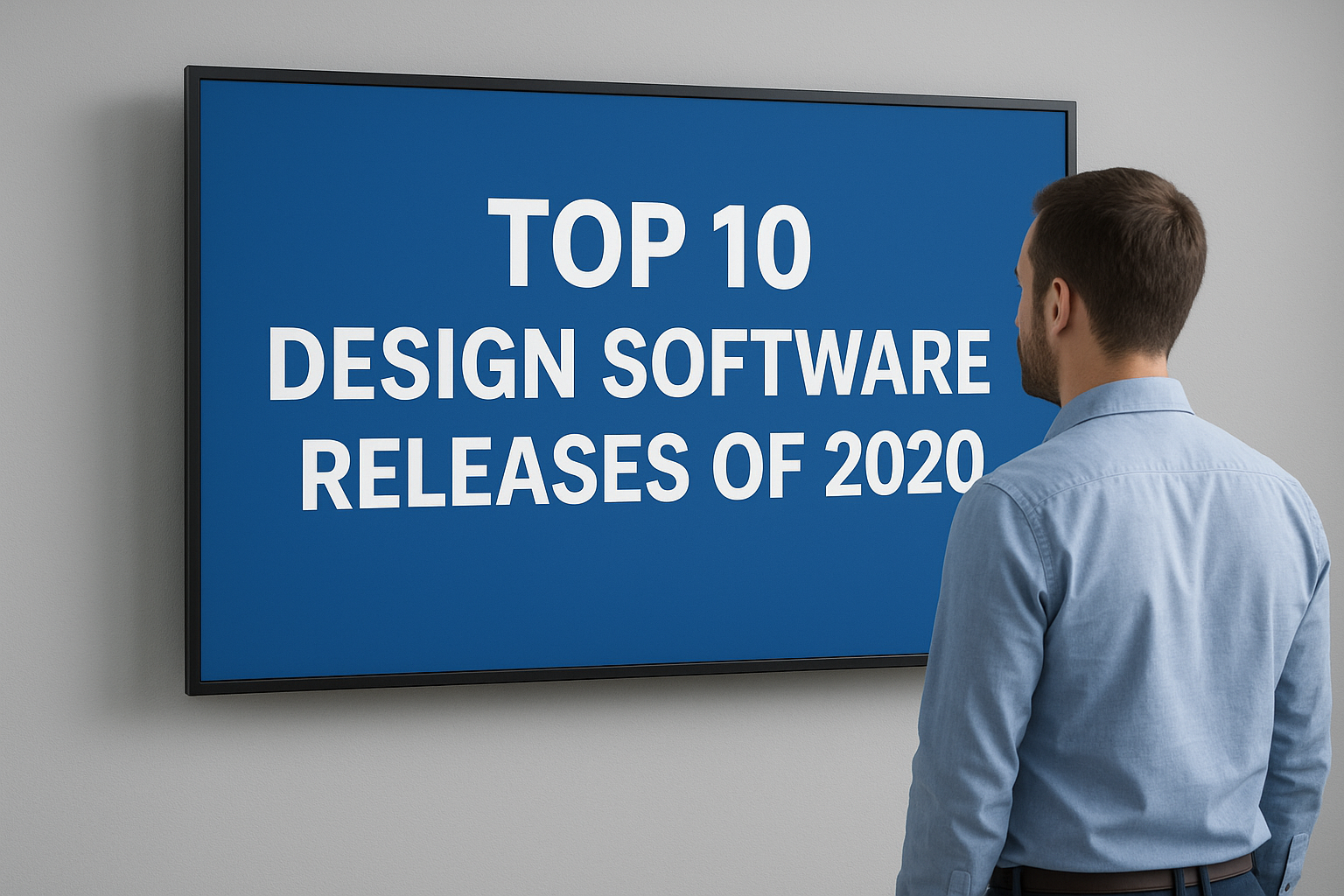Introduction
The year 2020 was a pivotal moment in modern history, fundamentally altering the landscape of work and creativity. As industries worldwide shifted to remote operations, the tools we use to create, collaborate, and communicate were thrust into the spotlight. This period of unprecedented change acted as a catalyst for rapid innovation within the software development sector. For designers, the demand for robust, cloud-native, and collaborative platforms became not just a preference but a necessity. The evolutionary trajectory of design tools accelerated, with 2020 serving as a critical benchmark.
This article provides a comprehensive retrospective of the top ten design software releases of that transformative year. Our analysis will delve into the key features, target audiences, and lasting impact of each application, offering a clear picture of how the 2020 design software market responded to the needs of a dispersed global workforce. The selection criteria for this list are based on a combination of factors: the significance of new features introduced, market adoption, user feedback, and the software’s overall contribution to design workflows during a critical period. The following overview of 2020 design software options highlights the tools that not only survived but thrived, setting new standards for the industry.
Adobe Photoshop 2020 (v21.0) – The Giant Reinvents Itself
As the industry standard for raster image editing, any update to Adobe Photoshop is a significant event. The 2020 release (version 21.0) was particularly noteworthy, as Adobe focused heavily on introducing powerful AI-driven features under the umbrella of “Adobe Sensei,” its artificial intelligence and machine learning platform. The primary goal was to automate tedious tasks, thereby freeing up designers to focus on more complex creative work.
A flagship feature introduced was the “Object Selection Tool.” This tool represented a substantial leap forward from the Quick Selection Tool. By simply drawing a rough rectangle or lasso around an object, Adobe Sensei would intelligently detect the object’s boundaries and make a precise selection. This dramatically reduced the time required for complex cutouts. Another major addition was “Preset Improvements,” which allowed for more intuitive scaling of patterns and gradients, resolving a long-standing frustration for many users.
Perhaps the most impactful feature for UI/UX and graphic designers was the “Properties Panel overhaul.” This update consolidated context-sensitive options, meaning that when a text layer was selected, all relevant text controls appeared in one place. The same applied to shapes, masks, and smart objects. This streamlined interface reduced clutter and minimized the need to hunt through myriad menus, significantly improving workflow efficiency. For artists, the addition of “Cloud Document” support, while in its early stages, signaled Adobe’s commitment to a more connected ecosystem, allowing for easier file sharing across devices. The 2020 release of Photoshop solidified its position as an essential piece of 2020 design software by addressing core usability issues with intelligent automation.
Figma (Continuous Updates) – The Collaboration Vanguard
While Figma had been gaining steady traction since its public launch in 2016, 2020 was unequivocally its breakthrough year. As design teams were forced to work remotely, Figma’s browser-first, real-time collaborative environment became the optimal solution. Its core differentiator was that it functioned like Google Docs for design: multiple team members could work on the same file simultaneously, seeing each other’s cursors, comments, and changes in real-time. This eliminated the cumbersome process of saving, exporting, and sending static files back and forth.
Throughout 2020, Figma rolled out a series of critical updates that enhanced its platform. The “Auto Layout” feature, which had been in beta, became more robust and widely adopted. Auto Layout allowed designers to create dynamic frames where elements would automatically resize and reorganize based on their content. This was a game-changer for designing responsive interfaces and component libraries, as padding, spacing, and alignment could be defined systematically, ensuring consistency across designs. Another significant update was the improvement to “Components” and “Variants,” which enabled designers to build more complex and flexible design systems directly within Figma.
Furthermore, Figma’s “Prototyping” capabilities saw substantial improvements, allowing for the creation of more sophisticated and high-fidelity user flows without needing third-party tools. The platform’s developer handoff features also matured, providing developers with clean code for CSS, iOS, and Android directly from the design file. By focusing relentlessly on collaboration, design systems, and a seamless end-to-end workflow, Figma established itself as the dominant force in UI/UX design. It was, without a doubt, one of the most influential platforms in the 2020 design software scene, fundamentally changing how design teams operate.
Affinity Designer 1.8 – The Formidable Challenger
Serif’s Affinity Designer continued its mission to provide a professional-grade alternative to Adobe Illustrator with its version 1.8 update. The Affinity suite, known for its one-time purchase model as opposed to a subscription, appealed to a growing segment of users frustrated with recurring fees. The 1.8 release was a monumental update that introduced a highly anticipated feature: full support for Adobe Photoshop (PSD) files.
This update allowed for the opening and editing of PSD files with impressive fidelity, including layer support, blending modes, and effects. This dramatically lowered the barrier to entry for users considering a switch from Adobe’s ecosystem. Beyond PSD support, version 1.8 brought a powerful new “Assets Panel,” enabling designers to create and manage libraries of commonly used icons, logos, and UI elements. The “Constraints” and “Symbols” features were also enhanced, making Affinity Designer a more viable tool for UI and web design, areas traditionally dominated by Sketch and Figma.
Performance improvements and the addition of new brush engines solidified its reputation for being both fast and versatile, capable of handling vector illustration, raster-based texture work, and layout design within a single application. Affinity Designer 1.8’s commitment to affordability, power, and interoperability made it a standout contender. It proved that serious competition in the vector graphics space was not only possible but thriving, marking it as a key player among the professional 2020 design software offerings.
Blender 2.90 – The Open-Source Powerhouse
The release of Blender 2.90 in August 2020 was a landmark event in the world of 3D creation. As a free and open-source application, Blender had already built a dedicated community, but this release showcased a level of polish and feature parity with expensive commercial software that turned industry heads. The update was a culmination of years of development, largely funded by an unprecedented wave of donations and corporate support.
The most significant addition in Blender 2.90 was a completely rewritten “Physics System,” which included high-performance cloth and fluid simulators. These new systems were not just minor improvements; they were robust enough for professional visual effects and animation work. The “Sculpt Mode” received major enhancements with the introduction of the “Cloth Brush” and “Multiresolution Displacement” support, bringing it closer to the capabilities of dedicated digital sculpting tools like ZBrush.
Furthermore, the “EEVEE render engine,” a real-time renderer, saw substantial improvements, making it faster and more accurate for producing final-quality images without the long wait times of traditional path tracers. The “Animation Toolset” was also refined with better grease pencil features and rigging tools. Blender 2.90 demonstrated that a community-driven project could innovate at a breathtaking pace. Its release in 2020 sent a clear message that high-end 3D creation was becoming increasingly accessible, solidifying its position as an indispensable tool for 3D artists and a remarkable achievement in 2020 design software.
Sketch 70+ (The Cloud Platform Shift)
Sketch, the application that initially popularized modern UI design, faced immense pressure in 2020 from the meteoric rise of Figma. In response, Sketch embarked on a fundamental strategic shift from being a macOS-native application to a cloud-platform-centric service. Throughout 2020, a series of updates (version 70 and beyond) were focused on rebuilding its collaboration features to compete effectively.
The most significant change was the introduction of “Workspaces,” which moved project management and collaboration to the web. Designers could now upload their Sketch files to a cloud workspace, where team members could view, inspect, and comment on prototypes in a web browser—even those on Windows machines. This was a crucial step towards overcoming Sketch’s limitation as a macOS-exclusive application. The “Libraries” feature was integrated into Workspaces, allowing for better synchronization of design system components across teams.
While Sketch’s performance and vector editing capabilities on the desktop remained excellent, the transition to a seamless cloud collaboration model was challenging and, in the eyes of some users, playing catch-up to Figma. However, for many established teams deeply invested in the macOS ecosystem and the powerful native performance of the Sketch app, these updates provided a viable path forward. The evolution of Sketch throughout 2020 represented a critical adaptation for a pioneer in the field, making it a significant subject of study in the landscape of 2020 design software.
Adobe XD (Sustained Innovation for UX)
Adobe Experience Design (XD) continued its rapid development cycle in 2020, adding a slew of features to solidify its position as a key player in the UX toolspace. As part of the Creative Cloud, XD benefited from deep integration with other Adobe apps like Photoshop and Illustrator, a significant advantage for users already within the ecosystem. Adobe’s strategy for XD was to create an all-in-one solution for designing, prototyping, and sharing user experiences.
Key updates in 2020 included enhanced “Voice Prototyping” capabilities, allowing designers to create experiences that responded to voice commands, a forward-looking feature for IoT and smart assistant applications. The “Components” system was made “State-Aware,” meaning a single component could have different visual states (e.g., default, hover, pressed, disabled), which greatly streamlined the design of interactive elements. Furthermore, improvements to “Auto-Animate” created more fluid and realistic transitions between artboards, enabling designers to build high-fidelity prototypes that felt like real applications.
Adobe also focused on developer handoff, improving the ability to generate design specs and assets for development teams. While Figma’s real-time collaboration was often cited as superior, Adobe XD’s relentless pace of innovation, coupled with its Creative Cloud integration, made it a compelling and powerful choice for many large organizations. Its developments throughout the year were a vital part of the competitive 2020 design software ecosystem for user experience professionals.
CorelDRAW Graphics Suite 2020 – The Veteran’s Update
CorelDRAW, a veteran in the vector graphics industry, released its 2020 version with a focus on performance, collaboration, and expanding its toolset to meet modern demands. Aimed at a broad audience from illustration to marketing and print production, this suite has maintained a loyal user base for decades. The 2020 update introduced several meaningful enhancements.
A standout feature was the new “Collaboration Hub,” which provided a centralized workspace within the application for sharing feedback and managing versions. This directly addressed the growing need for remote teamwork. The suite also introduced “AI-Powered PowerTRACE,” which leveraged machine learning to deliver more accurate bitmap-to-vector tracing results, a core function for many logo and illustration artists. Performance was a key focus, with claims of up to 10 times faster performance for opening complex, multi-layer files.
New tools like a “Pointillizer” for creating vector mosaic effects and enhanced support for modern file formats like HEIF (High Efficiency Image File) demonstrated Corel’s effort to keep the software current. While perhaps not generating the same buzz as newer, cloud-native platforms, CorelDRAW Graphics Suite 2020 represented a solid, comprehensive update for its professional user base. It underscored that established software companies were also actively adapting their offerings, contributing to the diverse range of available 2020 design software.
Canva – Empowering the Non-Designer
While not a traditional “professional” design application in the same vein as Adobe’s tools, Canva’s influence and growth in 2020 cannot be overlooked. The browser-based platform, designed to make graphic design accessible to everyone, saw explosive adoption as small businesses, educators, and marketing teams needed to create high-quality visual content quickly without a dedicated designer. Canva’s model is built on simplicity, templates, and a vast library of stock assets.
In 2020, Canva significantly expanded its “Canva for Teams” and “Canva for Education” offerings. It introduced new features like “Brand Kits,” which allowed teams to upload their logos, fonts, and color palettes to ensure brand consistency across all designs created on the platform. The “Magic Resize” tool, which could instantly adapt a design to different social media and print formats, saved an immense amount of time for content creators. The platform also deepened its integration with other services, making it easier to publish directly to social media channels or import data from sheets.
Canva’s success highlighted a crucial market segment: the democratization of design. By empowering millions of non-designers to create visually competent materials, it carved out a massive niche. Its evolution in 2020 was a testament to the expanding definition of design tools, making it a uniquely important entry in the discussion of impactful 2020 design software.
- Procreate 5X – Redefining Digital Art on iPad
Procreate, an iPad-exclusive application, released its 5X update, further cementing the iPad Pro as a serious tool for professional artists and illustrators. Procreate’s strength lies in its intuitive touch-first interface, powerful brush engine, and astonishingly low one-time price. The 5X update was a major release that introduced groundbreaking animation capabilities.
The new “Animation Assist” feature transformed Procreate from a static illustration app into a capable 2D animation studio. It provided an intuitive timeline, onion skinning, and the ability to create simple frame-by-frame animations directly on the iPad. This opened up new creative possibilities for artists, illustrators, and social media content creators. Alongside animation, the update brought a new “Brush Studio” with advanced controls, “Color Dynamics” for more realistic brushes, and the ability to import and export custom brushes with ease.
Procreate’s continuous innovation on a mobile platform challenged the notion that serious design work must be done on a desktop computer. Its focus on a seamless, gesture-based drawing experience, combined with pro-level features, made it an indispensable tool for digital artists worldwide. The Procreate 5X update was a shining example of how 2020 design software was pushing the boundaries of platform-specific creativity.
Unity 2020 LTS – The Real-Time Revolution
While primarily a game engine, Unity’s influence extends far beyond gaming into architecture, film, automotive design, and virtual reality. The 2020 LTS (Long-Term Support) release was a milestone of stability and features, making real-time 3D creation more accessible and powerful. For designers in adjacent fields, Unity became a platform for creating immersive, interactive experiences.
Key features included updates to the “Universal Render Pipeline (URP),” which provided optimized graphics performance for a wide range of platforms, from mobile to high-end PCs. The “Shader Graph” and “VFX Graph” tools allowed artists to create complex visual effects and materials without writing code. Furthermore, improvements in “AR Foundation” simplified the development of augmented reality applications for both iOS and Android from a single codebase.
For designers, the ability to create real-time walkthroughs of architectural spaces or interactive product configurators became increasingly viable with Unity. The 2020 LTS release represented a mature, reliable version of the engine that professionals could build upon. It highlighted the convergence of traditional design disciplines with real-time technology, marking it as a critical and versatile tool in the broader context of 2020 design software.
Conclusion
The year 2020 was a crucible that tested and ultimately accelerated the evolution of digital design tools. The software releases of that year were characterized by a clear and urgent focus on collaboration, accessibility, and intelligent automation. From the AI-powered enhancements in Adobe’s suite to the collaborative revolution led by Figma, and from the open-source triumph of Blender to the platform-shifting strategies of Sketch, the market dynamic was one of intense and fruitful competition. The landscape of 2020 design software was not defined by a single winner, but by a diverse array of tools that collectively raised the bar for what designers could achieve. These applications empowered creatives to overcome the challenges of remote work and continue to produce exceptional work under extraordinary circumstances. The innovations introduced during this period have had a lasting impact, shaping the design workflows and tool expectations that continue to evolve today. The legacy of these top ten 2020 design software releases is a more connected, efficient, and powerful creative toolkit for professionals across all disciplines.







